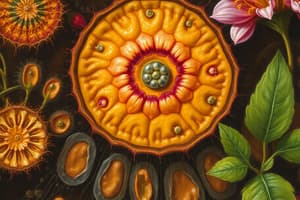Podcast
Questions and Answers
Which of the following statements accurately describes a characteristic of living things?
Which of the following statements accurately describes a characteristic of living things?
- Living things cannot grow.
- Living things are unable to move.
- Living things do not depend on their environment.
- Living things reproduce. (correct)
What is the function of chloroplasts in plant cells?
What is the function of chloroplasts in plant cells?
- To perform photosynthesis. (correct)
- To regulate cell activities.
- To produce energy from sugar.
- To store waste and water.
Which cell structure is primarily responsible for the cell's energy production?
Which cell structure is primarily responsible for the cell's energy production?
- Mitochondria (correct)
- Nucleus
- Chloroplast
- Cell wall
When using a microscope, which should you avoid doing when at 40x magnification?
When using a microscope, which should you avoid doing when at 40x magnification?
Which of the following structures functions similarly to a recycling plant in a cell?
Which of the following structures functions similarly to a recycling plant in a cell?
Flashcards
What are the characteristics of living things?
What are the characteristics of living things?
Living things move, reproduce, breathe, grow, and depend on their environment. These are the key features that differentiate living organisms from non-living things.
What is the function of the cell wall in a plant cell?
What is the function of the cell wall in a plant cell?
The cell wall provides structural support and protection to the plant cell, like a rigid frame or clothing.
What does the chloroplast do in a plant cell?
What does the chloroplast do in a plant cell?
Chloroplasts are responsible for photosynthesis, the process of converting sunlight into energy. They are like solar panels in a plant cell.
What is the function of the nucleus?
What is the function of the nucleus?
Signup and view all the flashcards
What is the role of the mitochondria in a cell?
What is the role of the mitochondria in a cell?
Signup and view all the flashcards
Study Notes
Characteristics of Living Things
- Living things move.
- Living things reproduce.
- Living things breathe.
- Living things grow.
- Living things depend on their environment.
Plant vs. Animal Cells
Plant Cells
- Cell Wall: Provides structural support to the plant cell.
- Chloroplast: Site of photosynthesis.
- Vacuole: Stores water, food, and waste (larger in plants).
Both Plant and Animal Cells
- Cell Membrane: Regulates what enters and exits the cell.
- Nucleus: Contains DNA and controls cell activities.
- Mitochondria: Produces energy for the cell.
- Endoplasmic Reticulum (ER): Transports materials within the cell.
- Golgi Apparatus: Packages and stores proteins.
- Lysosome: Breaks down harmful or large substances.
- Ribosome: Produces proteins.
Microscope Safety Rules
- Keep your workspace clear.
- Hold the microscope by the arm and base.
- Handle slides with care.
- Start with the lowest magnification.
- Do not use the coarse focus knob with high magnification (40x).
- Turn off the microscope and cover it before storing.
Studying That Suits You
Use AI to generate personalized quizzes and flashcards to suit your learning preferences.
Description
This quiz covers the basic characteristics of living things, differentiating between plant and animal cells, and essential microscope safety rules. Test your understanding of these fundamental concepts in biology.




